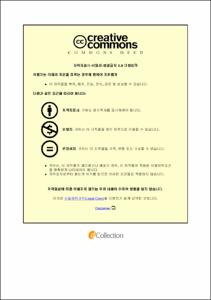Ulsan Univ. Repository
Thesis
General Graduate School
Mechanical & Automotive Engineering
1. Theses (Master)
12 L 급 디젤 엔진용 Cu-Zeolite SCR 촉매의 NOx 저감 성능에 관한 실험적 연구
- Abstract
- In this thesis, a study on the NOx reduction performance of Cu-Zeolite SCR catalyst at a constant speed and transition mode for large commercial vehicles was conducted.
The SCR catalyst showed low NOx reduction performance because the catalyst was not activated below a certain temperature. This phenomenon determines the operating section of the SCR and consequently directly affects the NOx reduction efficiency. Cu-Zeolite catalyst has excellent NOx reduction performance in cold operation and initial operation mode due to low SCR activation temperature. In addition, the emission of ammonia used for NOx reduction in SCR is also limited. In order to control ammonia slip discharged along with the exhaust gas, the amount of ammonia required for NOx reduction and the amount of ammonia adsorption of the SCR catalyst are important factors. The Cu-Zeolite catalyst is advantageous for SCR control due to a large amount of ammonia adsorption.
The experiment in the transition operation area was performed using the transition operation cycle WHTC Cycle, which is used as a test cycle from Euro 6 in European vehicle exhaust regulation standards for trucks and buses, and cold WHTC and Hot WHTC was performed in two ways.
The experiment in the constant speed operation area was carried out using the constant speed operation cycle WHSC Cycle, which is used as a test cycle from Euro 6 along with WHTC. In the case of WHSC, the mode was performed after preheating for 10 minutes under the conditions specified in the test mode and then soaking for 5 minutes.
During the mode test, urea water injection was controlled to start after the temperature of the SCR reached the active temperature of the SCR. In the case of WHTC, the time to reach the active temperature due to the temperature drop due to the rapid torque change is longer than that in the WHSC mode, and thus the NOx reduction rate after reaching the active temperature remained high, but the overall Nox reduction rate was compared to WHSC. It was measured low.
The performance of the Cu-Zeolite catalyst was compared with the conventionally used vanadium catalyst. Compared to the vanadium catalyst, the Cu-Zeolite catalyst exhibited a high NOx reduction rate because the urea water was sprayed earlier in the mode test because the temperature at which the catalyst was activated was lower. As the temperature of both vanadium and Cu-Zeolite catalysts increased, the ammonia adsorption amount of the catalyst decreased. However, the ammonia adsorption amount of the vanadium catalyst was also small at low temperature, causing the ammonia adsorbed to the SCR at high temperature to slip. In the case of the Cu-Zeolite catalyst, the ammonia adsorption amount is large, which is advantageous for controlling the injection of urea water, thereby achieving high NOx reduction and at the same time preventing ammonia slip.|본 연구에서는 대형 상용차용 정속, 천이 운전모드에서의 Cu-Zeolite SCR 촉매의 NOx 저감 성능에 대한 연구를 실시하였다.
SCR 촉매는 일정 온도 이하에서는 촉매가 활성되지 않아 낮은 NOx 저감 성능을 보였다. 이러한 현상은 SCR의 작동구간을 결정하고 결과적으로 NOx 저감효율에 직접적인 영향을 미친다. Cu-Zeolite 촉매는 이러한 SCR 활성온도가 낮아 냉간운전 및 초기 운전모드에서의 NOx 저감 성능이 우수하다. 또한 SCR에서 NOx 저감을 위해 사용되는 암모니아 역시 배출이 제한되는데 암모니아가 배기가스와 함께 배출되는 암모니아 슬립을 컨트롤하기 위해서는 NOx 저감에 필요한 암모니아 양과 SCR 촉매의 암모니아 흡착량이 중요한 요인이다. Cu-Zeolite 촉매는 암모니아 흡착량이 많아 SCR 제어에 유리하다.
천이운전영역에서의 실험은 트럭과 버스의 유럽자동차배기가스 규제표준에서 Euro 6부터 시험주기로 사용되는 천이운전 사이클 WHTC Cycle을 이용하여 수행하였고 냉간시동과 고온시동 시의 결과를 테스트하기 위해 cold WHTC와 hot WHTC, 두 가지로 수행되었다.
정속운전영역에서의 실험은 WHTC와 함께 Euro 6부터 시험주기로 사용되는 속운전 사이클 WHSC Cycle을 이용하여 수행되었다. WHSC의 경우에는 시험모드에 명시된 조건으로 10분간 예열한 뒤 5분간 소킹한 후 모드를 수행하였다.
모드시험 중 요소수 분사는 SCR의 온도가 SCR의 활성온도에 도달한 이후 시작하도록 제어하였다. WHTC의 경우 급격한 토크 변화로 인한 온도 하락으로 활성온도에 도달하는 시간이 WHSC 모드에 비해 오래 걸리고 그로 인해서 활성온도에 도달한 이후의 NOx 저감률은 높은 값을 유지하였지만 전체 Nox 저감률은 WHSC에 비해 낮게 측정되었다.
Cu-Zeolite 촉매의 성능을 기존에 일반적으로 사용되는 바나듐 촉매와 비교 실험을 수행하였다. Cu-Zeolite 촉매는 바나듐 촉매과 비교하여 촉매가 활성화되는 온도가 낮아 모드 시험 시 요소수가 분사되는 시점이 빨라 NOx 저감률이 높았다. 바나듐과 Cu-Zeolite 촉매 모두 온도가 상승함에 따라 촉매의 암모니아 흡착량이 감소하였는데 바나듐 촉매은 저온에서의 암모니아 흡착량도 적어 고온에서 SCR에 흡착되어 있던 암모니아가 슬립되는 현상이 발생하였다. Cu-Zeolite 촉매의 경우 암모니아 흡착량이 커 요소수 분사 제어에 유리하여 높은 NOx저감을 달성하며 동시에 암모니아 슬립을 방지할 수 있었다.
- Issued Date
- 2021
- Awarded Date
- 2021-02
- Type
- Dissertation
- Keyword
- Cu-Zeolite SCR; NH3 Adsorption; Nitrogen oxides; WHTC; WHSC
- Alternative Author(s)
- DongGyu Yu
- Affiliation
- 울산대학교
- Department
- 일반대학원 기계자동차공학과
- Advisor
- 임옥택
- Degree
- Master
- Publisher
- 울산대학교 일반대학원 기계자동차공학과
- Language
- kor
- Appears in Collections:
- Mechanical & Automotive Engineering > 1. Theses (Master)
- 파일 목록
-
-
Download
 200000372462.pdf
기타 데이터 / 3.45 MB / Adobe PDF
200000372462.pdf
기타 데이터 / 3.45 MB / Adobe PDF
-
Items in Repository are protected by copyright, with all rights reserved, unless otherwise indicated.